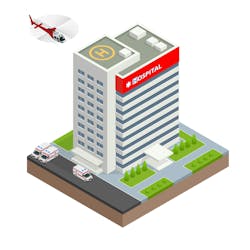For any healthcare organization, delivering excellent patient care is a top priority, but creating a secure facility is an often overlooked aspect of achieving that goal. Being able to plan for potential incidents, notify the right people, and actively manage events lets hospital staff know that their safety and their patients’ safety are being prioritized so they can focus their efforts on delivering excellent care. However, if healthcare organizations do not have the right tools in place, it can be difficult to respond effectively when an emergency occurs. Incident management software can be a powerful solution when appropriately deployed as healthcare organizations look to combat multiple threats that may disrupt operations. Here are some ways healthcare organizations can achieve holistic security at their facilities with incident management software.
Plan for Potential Threats
To effectively leverage incident management tools, healthcare organizations need to understand the threats that can occur that would harm people or disrupt operations. Depending on the size of a facility, its location, and the services it provides, threats may vary, which is why it is important to bring together a group of representatives from different departments who can provide perspectives on various security and operational concerns. These issues can range from violent intruders to severe weather that may impact staffing, but the more comprehensive a list that is created, the better prepared an organization will be. With the list in hand, organization leaders can then determine workflows for addressing threats and messaging to best communicate to staff, patients, and visitors what is happening and what steps they should take to stay out of harm’s way.
Advanced planning can make an incident management tool more effective. It is less likely critical steps are missed in building out messages and procedures, and it helps reduce the workload when an incident occurs as every step has already been thought through.
Detect Potential Threats
Multiple tools are available that healthcare organizations can connect with their incident management software to help detect threats and initiate the management process. Panic buttons are a quick and effective way to signal that an issue is taking place and in healthcare environments, and multiple types of panic buttons may be needed to ensure easy access. Wearable devices can be given to each staff member, helping to reinforce that their safety is a priority. These devices can be engaged when dealing with difficult patients are when someone sees suspicious or violent activity ina facility. Physical panic buttons can be mounted in patient rooms, hallways, or other high-traffic areas. Keyboard shortcuts can also be configured at nurses’ stations and mobile apps can be used by staff whether they are within a building or nearby and need assistance. This can be particularly helpful if staff are working odd hours and need to walk alone to their car in a space where help is otherwise not readily available. Panic button apps can share their location and give them direct access to security teams via a phone call until help arrives.
Panic buttons offer a powerful manual method for detecting threats, but automated methods can provide even more advance warning for a healthcare organization looking to minimize the impact of a threat. Incident management systems that monitor feeds from the National Weather Service can give healthcare organizations advanced notice about severe weather events that may impact operations or cause an influx of patients. Sensors can be connected to detect spills, hazardous materials, and air quality, and AI video surveillance can send alerts when a gun is drawn or other suspicious or dangerous activity occurs. This speeds up the alerting process so staff can intervene quickly before situations get out of hand.
Deliver Actionable Notifications
Once an alert has been initiated, the right people must receive it in the shortest amount of time. In some cases that may mean sending an alert throughout an entire building, and in others, it may only require alerting specific teams, like security personnel and administrators. Incident management systems that offer the ability to designate groups and zones for targeted messaging can help ensure messages are delivered to the right people at the right time. It can also help restrict messages to relevant areas, avoiding sending sensitive messages to areas like visitor lobbies that may not need to be notified.
Those messages need to spur people to action so they stay out of harm’s way. That can only be accomplished if messages reach them immediately. Robust incident management systems offer multi-channel alerting to reach people wherever they are with intrusive messaging that grabs their attention. With the ability to integrate with existing technology in a healthcare facility, including desk phones, desktop computers, digital signage, IP speakers, paging systems, and mobile devices, organizations can deliver text, audio, and visual messages that are impossible to ignore, getting information into the hands of the people who need it the moment they need it.
Manage Events from Start to Finish
Once an event has occurred and notifications have been sent out to alert others, healthcare organizations need to manage the event to bring about a successful resolution. This is where incident management software has an advantage over other alerting tools. While being able to share information is helpful, critical incidents are complex events and need sophisticated solutions to handle them. With incident management, healthcare organizations can plan for every step of a crisis and have those steps readily available to help minimize confusion and speed up the response process.
This can include prebuilding specific messages for different stages of an event, from an initial alert and follow-up details to the final “all clear” message. In addition, specific messages can be sent to key stakeholders asking them to join virtual incident response rooms so they can assess the situation and determine the best course of action. Stakeholders can use resources they upload into their system, like floorplans, safety checklists, and links to camera feeds. They can also view real-time insights from their constituents by sending out notifications that ask for a response to determine who is safe and who needs assistance.
Each of these components can help healthcare organizations have a better understanding of the situation as it unfolds so they can better direct resources to help those in need and reduce the impact of daily operations.
Resume Normal Operations
Part of being able to deliver excellent patient care is persevering in the face of a security threat. While certain activities may need to be paused to address an event as it happens, being able to get back up and running quickly enables a healthcare organization to continue to serve its patients with the best possible care.
Having pre-built messages and multichannel alerting means that organizations can let their people know that the danger has passed the moment it is deemed safe to resume normal operations. This can significantly reduce downtime by getting people back inside buildings and returning to work.
While it is impossible to anticipate every security issue that may arise within a healthcare organization, some steps can be taken and tools can be implemented that will simplify and speed up response times to help deal with a situation when it occurs. Incident management software can provide a rich, customizable toolset for healthcare organizations to plan for and actively manage incidents. With strong incident management strategies in place, organizations can create a secure environment focused on delivering exemplary patient care.



